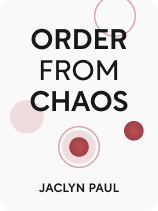

This article is an excerpt from the Shortform book guide to "Order From Chaos" by Jaclyn Paul. Shortform has the world's best summaries and analyses of books you should be reading.
Like this article? Sign up for a free trial here.
Why does ADHD cause disorganization? How hard is it to stay organized with ADHD?
ADHD can cause you to make impulsive decisions, struggle to stop a task once you’ve begun it, and have difficulty conforming to common organizational methods. These and other traits can make you disorganized, and being disorganized can then make your symptoms worse, creating a negative cycle.
Let’s look at ways to clean up your messy habits so you can get your life in order, according to Order From Chaos by Jaclyn Paul,
Contain Your Current Mess
According to Paul, if you’re already behind on your organization, you won’t be able to jump right into a new system. You need to get a handle on your current state of disorganization. ADHDers can become disorganized more easily because they tend to quickly be overwhelmed by new input, and we’re all constantly receiving various types of input: Much of it is informational like ideas and obligations, and much of it is physical like mail and belongings. For ADHDers, the overwhelm from all this input often leads to piles.
(Shortform note: ADHDers may not even realize how messy their environment has gotten because they often experience clutter blindness, which is when they become so accustomed to the mess around them that it no longer looks messy. Sometimes it can help to ask a friend or loved one to help you identify cluttered areas in your environment so you know where to start containing your mess.)
Piles accumulate when we have no system for dealing with incoming stuff. We get a piece of mail or find a dirty sock on the floor and put it in a pile for us to deal with later, which grows and grows until it feels too big to manage. These piles feel necessary—particularly for those who suffer from “out of sight, out of mind” tendencies—so that we don’t lose track of important items, but ultimately these things tend to get lost in the piles anyway.
Organizing piles starts with containing them, which means designating a specific location to keep those items until you’re ready to deal with them.
(Shortform note: Some ADHDers use piles as an important part of their organizing system, often referring to them as “DOOM” piles (“Didn’t Organize, Only Moved). They may come in other forms than piles, including bags, boxes, drawers, or other containers. DOOM piles can be useful when you’re organizing on limited time or energy and need to get rid of clutter or mess. However, as with other piles, they need to be managed regularly—perhaps in one of the ways we’re about to describe—so they don’t get out of control.)
Containing Physical Items
To contain physical items that you struggle to keep organized, Paul recommends using baskets. While it may seem similar to a pile, a basket provides physical boundaries for a pile, which will help keep it more manageable. Each basket should only contain one type of item. That way, as soon as you find an item that needs to be stored, you know exactly where to put it, and you know exactly where to look for it the next time you need it.
(Shortform note: You can continue to tap into your learning styles and needs as you create your containment system. If you’re a visual learner, color-coding your baskets—say, using a red basket for household items, a blue basket for important documents, and so on—may help you keep track of them. Tactile learners may benefit from having to perform an additional physical step to put something in a basket (perhaps unlatching and opening the basket’s lid), and auditory learners could talk through their organizational choices with someone to solidify them in their minds.)
Also, remember your learning style (and those of any ADHDers with whom you may share your space): If you know you have “out of sight, out of mind” tendencies, putting items in a place where you can’t see them won’t be sustainable. If you don’t use the items frequently, you’ll forget about them. If you do use them frequently, you’ll never be able to keep up with a system that hides them from your sight because you’ll inevitably start leaving them outside of their container due to your need to keep visual track of them. To beat your “out of sight, out of mind” tendencies, use open containers that will help you use those items as visual reminders without them being strewn all over the place.
| Organizing by What You Use Most Often If you’re using baskets to contain a particular type of item, you might find your frequently used items keep getting mixed in with items you don’t need that much. For example, if you have a basket filled with office supplies, but you rarely use any of them except the stapler, you might get frustrated always having to dig past the tape dispensers, scissors, boxes of paper clips, and other items to get to the stapler. In Algorithms to Live By, Brian Christian and Tom Griffiths suggest sorting your belongings based on what you use the most often. If you sort through your basket and find items that you almost never use or haven’t used in a long time, consider putting those items in a less accessible but more organized space, or even getting rid of them entirely. |
Containing Email and Calendar Reminders
You may also have different “piles,” such as thousands of unread emails, mountains of written reminders, or digital calendars filled with things you may or may not do. These are also things that need to be contained, insists Paul.
To better contain your emails and calendar reminders, be ruthless about what you keep and what you don’t. If you have what feels like an overwhelming amount of unread emails, consider deleting all emails received before a certain date to clear out the current clutter. Then downsize: Unsubscribe from any newsletters, promotional emails, or other things you don’t use. Similarly, with your calendar, only include items that have to be done and are time sensitive. Filling your calendar with things you may or may not do is a recipe for an abandoned calendar.
| Other Tips for Managing Email and Calendar Other organization experts offer tips for general email and calendar maintenance that ADHDers could consider combining with Paul’s recommendations: For email, they suggest only checking your email during certain times of the day, dealing with an email as soon as you read it instead of leaving it marked as “read,” and using email templates to help you save time on drafting emails that you send regularly. When you deal with emails right away, you prevent an overwhelming amount of unread emails from accumulating, and thus may not even have to downsize. For your calendar, they recommend color-coding your different activities based on the type of activity. For example, you could code all your work commitments in red, your free time in blue, and your errands in green—then you can see at a glance if your time commitments are way out of balance. They also recommend being judicious about which calendar invites you choose to accept and making sure your calendar is synced across all your devices. |
Thought Containers
ADHDers also have trouble remembering things without concrete reminders. Rather than assuming you’ll remember something, Paul recommends creating thought containers by finding a way to record your thoughts immediately, before they can slip out of your mind, and storing those thoughts in a way that will make them easy to access later. This might mean keeping a dry-erase board in every room of your house or always having a pad of sticky notes on hand that you then store in a physical container.
This can also be helpful when other people need to ask you to do something. If your child needs a permission slip signed, or your coworker needs you to take the lead on a new project, they can put a note into your thought container to ensure you attend to it.
| Additional Ways to Organize Your Thoughts Sometimes you may not make it to your thought container before you lose your thought. Research shows that talking to yourself can help your concentration and processing. It also helps you remember and establish mental associations between your thoughts and a specific visual target, so saying your thought out loud can help you keep it in your memory until you can either write it down or perform the action it requires. To avoid forgetting what you were about to do before you walked into a room, try using the P-L-R technique: Pause for 10 seconds, then use that time to Link your intended action to a verbal description and a visual image of the task. Finally, Rehearse the image and description in your mind so it will stick long enough for you to get it done. |

———End of Preview———
Like what you just read? Read the rest of the world's best book summary and analysis of Jaclyn Paul's "Order From Chaos" at Shortform.
Here's what you'll find in our full Order From Chaos summary:
- What ADHD is and how it affects cognitive functioning
- How those with ADHD can gain control over their lives and find peace
- How to implement an organization system that works with your needs






